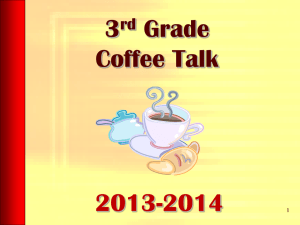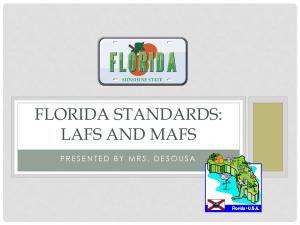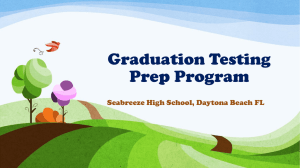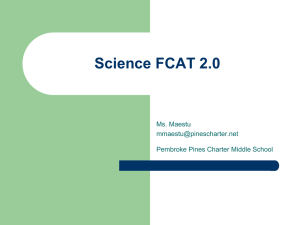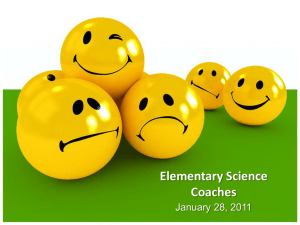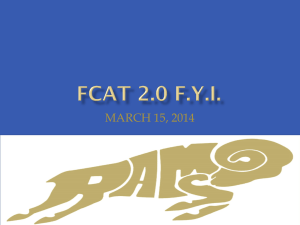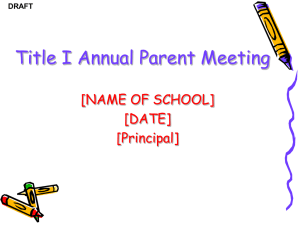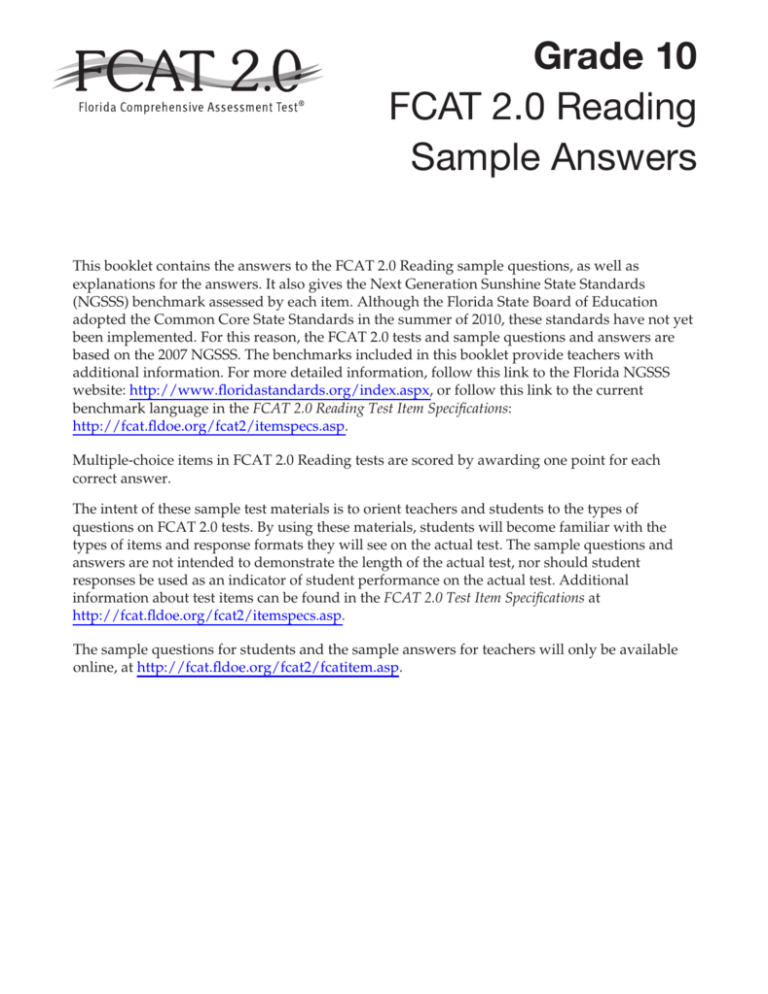
Grade 10
FCAT 2.0 Reading
Sample Answers
This booklet contains the answers to the FCAT 2.0 Reading sample questions, as well as
explanations for the answers. It also gives the Next Generation Sunshine State Standards
(NGSSS) benchmark assessed by each item. Although the Florida State Board of Education
adopted the Common Core State Standards in the summer of 2010, these standards have not yet
been implemented. For this reason, the FCAT 2.0 tests and sample questions and answers are
based on the 2007 NGSSS. The benchmarks included in this booklet provide teachers with
additional information. For more detailed information, follow this link to the Florida NGSSS
website: http://www.floridastandards.org/index.aspx, or follow this link to the current
benchmark language in the FCAT 2.0 Reading Test Item Specifications:
http://fcat.fldoe.org/fcat2/itemspecs.asp.
Multiple-choice items in FCAT 2.0 Reading tests are scored by awarding one point for each
correct answer.
The intent of these sample test materials is to orient teachers and students to the types of
questions on FCAT 2.0 tests. By using these materials, students will become familiar with the
types of items and response formats they will see on the actual test. The sample questions and
answers are not intended to demonstrate the length of the actual test, nor should student
responses be used as an indicator of student performance on the actual test. Additional
information about test items can be found in the FCAT 2.0 Test Item Specifications at
http://fcat.fldoe.org/fcat2/itemspecs.asp.
The sample questions for students and the sample answers for teachers will only be available
online, at http://fcat.fldoe.org/fcat2/fcatitem.asp.
SAMPLE
10
FCAT 2.0 Reading Sample Answers
Article: “The Enigma of the Echidna”
“The Enigma of the Echidna” by Doug Stewart. Reprinted by permission of the author. Copyright © 1996–2003. Published in the National Wildlife
Federation, Oct/Nov 2003. All rights reserved. “14 day old baby echidna (Puggle)”: Reprinted by permission of Mike McKelvey, Photographer. All rights
reserved. “Echidna”: © Staffan Widstrand/CORBIS.
1
The correct answer is C (the unpredictable behavior of echidnas, which makes
the animals puzzling subjects to study).
Type of Text: Informational
Benchmark: LA.910.1.6.8
The student will identify advanced word/phrase
relationships and their meanings.
The correct answer is C. According to the author, Elusive and unpredictable, echidnas
continue to perplex the scientific world with their oddities. Biologist Peggy Rismiller states,
“Every time you think you know what they’re going to do, they do something different.”
2
The correct answer is F (drinking rainwater and using solar energy).
Type of Text: Informational
Benchmark: LA.910.6.2.2
The student will organize, synthesize, analyze, and
evaluate the validity and reliability of information from multiple sources
(including primary and secondary sources) to draw conclusions using a variety of
techniques, and correctly use standardized citations.
The correct answer is F. The Pelican Lagoon Research and Wildlife Centre on South
Australia’s remote Kangaroo Island is a nonprofit educational trust (managed by
biologists Peggy Rismiller and Mike McKelvey) that specializes in low-impact field research.
According to the author, It’s the sort of place where computers are solar-powered and rain
provides drinking water.
Page 2
FCAT 2.0 Reading Sample Answers
Florida Department of Education
SAMPLE
FCAT 2.0 Reading Sample Answers
3
10
The correct answer is C (Transmitters are difficult to acquire).
Type of Text: Informational
Benchmark: LA.910.1.7.3
The student will determine the main idea or essential
message in grade-level or higher texts through inferring, paraphrasing,
summarizing, and identifying relevant details.
The correct answer is C. Tracking echidnas with radio transmitters is challenging for
several reasons. According to biologist Mike McKelvey, echidnas are “built low to the
ground” and “they spend a lot of time in burrows and caves, which block the signal.” In
addition, biologists find attaching a transmitter to a single spine challenging. Many
echidnas shed their transmitters, and some may have learned to scrape them off between
rocks; however, the article makes no reference to any difficulty with acquiring
transmitters for tracking echidnas.
4
The correct answer is F (the production of milk).
Type of Text: Informational
Benchmark: LA.910.1.7.7
multiple texts.
The student will compare and contrast elements in
The correct answer is F. According to the article, Like other mammals, echidnas are hairy and
milk-bearing. The characteristics in the other answer options are not shared by echidnas
and other mammals.
Page 3
FCAT 2.0 Reading Sample Answers
Florida Department of Education
SAMPLE
5
10
FCAT 2.0 Reading Sample Answers
The correct answer is B (physical appearance).
Type of Text: Informational
Benchmark: LA.910.1.7.7
multiple texts.
The student will compare and contrast elements in
The correct answer is B. Echidnas and porcupines are similar with regard to their
physical appearance, and echidnas are often referred to by the people of Australia as
porkies, although their spines are very different from a porcupine’s quills. Options A, C,
and D indicate differences between the two mammals.
6
The correct answer is I (decreased living space and human intrusion).
Type of Text: Informational
Benchmark: LA.910.1.7.3
The student will determine the main idea or essential
message in grade-level or higher texts through inferring, paraphrasing,
summarizing, and identifying relevant details.
The correct answer is I. According to the author, Outside conservation areas, habitat loss and
fast-moving vehicles are perhaps the species’ gravest threat.
Page 4
FCAT 2.0 Reading Sample Answers
Florida Department of Education
SAMPLE
FCAT 2.0 Reading Sample Answers
7
10
The correct answer is C (the ruggedness of the terrain where echidnas dwell).
Type of Text: Informational
Benchmark: LA.910.6.2.2
The student will organize, synthesize, analyze, and
evaluate the validity and reliability of information from multiple sources
(including primary and secondary sources) to draw conclusions using a variety of
techniques, and correctly use standardized citations.
The correct answer is C. The author presents information about the difficulties of
trapping and radio-tagging echidnas. He also states that echidnas are among the most
widely, if sparsely, distributed of all Australian mammals. These factors account for the
uncertainty biologists have in determining the total echidna population. However, the
ruggedness of the terrain where echidnas dwell does not account for this uncertainty, as
the species is wandering and burrowing its way across rain forest, desert, bush, swamp and
seashore.
Page 5
FCAT 2.0 Reading Sample Answers
Florida Department of Education
SAMPLE
10
FCAT 2.0 Reading Sample Answers
Functional Text: “Quest-4 Cell Phone—User Manual”
“Quest-4 Cell Phone—User Manual” property of the Florida Department of Education.
8
The correct answer is H (She switched the computer’s application from
keyboard to voice mode).
Type of Text: Informational
Benchmark: LA.910.1.6.9
The student will determine the correct meaning of
words with multiple meanings in context.
The correct answer is H. Both the excerpted sentence and the sentence in option H use
the meaning of the word mode in a context applying to technology, referring to a
particular functioning condition of an electronic device.
9
The correct answer is C (provides a key for categories of calendar entries).
Type of Text: Informational
Benchmark: LA.910.1.7.7
multiple texts.
The student will compare and contrast elements in
The correct answer is C. The CALENDAR SYMBOLS chart is the only text feature in the
user manual that offers readers information about the calendar feature of the Quest-4 cell
phone in the form of a key, using symbols to represent reminders, calls, tasks, and events.
Page 6
FCAT 2.0 Reading Sample Answers
Florida Department of Education
SAMPLE
FCAT 2.0 Reading Sample Answers
10
10
The correct answer is I (being in a location where a GPS signal is available).
Type of Text: Informational
Benchmark: LA.910.1.7.3
The student will determine the main idea or essential
message in grade-level or higher texts through inferring, paraphrasing,
summarizing, and identifying relevant details.
The correct answer is I. According to the user manual, where a Global Positioning
System (GPS) signal is available, the Quest-4 cell phone will automatically seek
information and report the user’s approximate location. For the Enhanced Emergency
Service (EES) to be fully functional, the manual makes no reference to requirements that
the user pay for the EES option or know how to operate GPS technology. The manual
does reference the importance of reporting a location accurately in cases where a GPS
signal is not available, but this is not an actual requirement for the EES function.
Page 7
FCAT 2.0 Reading Sample Answers
Florida Department of Education
SAMPLE
11
10
FCAT 2.0 Reading Sample Answers
The correct answer is B (labels).
Type of Text: Informational
Benchmark: LA.910.6.1.1
The student will explain how text features (e.g.,
charts, maps, diagrams, subheadings, captions, illustrations, graphs) aid the
reader’s understanding.
The correct answer is B. The symbols function only to label the four categories of entries
the user can make in the Quest-4 cell phone. The symbols do not indicate locations of any
phone feature, describe effects of any feature of the phone, or operate as switches for any
function of the phone.
12
The correct answer is G (The calendar will store an entry for every day of
the year).
Type of Text: Informational
Benchmark: LA.910.6.2.2
The student will organize, synthesize, analyze, and
evaluate the validity and reliability of information from multiple sources
(including primary and secondary sources) to draw conclusions using a variety of
techniques, and correctly use standardized citations.
The correct answer is G. The user manual states: To erase all entries, choose Options and
then choose Erase All; Choose Ring Tone or Preset Melody to remind you of this date; and A
list of locations and corresponding emergency numbers displays. While the calendar will store
many entries, the manual states that Your Quest-4 cell phone will hold up to 300 calendar
entries, making it incapable of holding an entry for every day of the year.
Page 8
FCAT 2.0 Reading Sample Answers
Florida Department of Education
SAMPLE
FCAT 2.0 Reading Sample Answers
10
Article: “The Height of Ingenuity”
“The Height of Ingenuity” by Norman Vanamee. Copyright © 2003 Norman Vanamee. From the New York Times Magazine. Reprinted by permission. “Sprint
Voyager”: Courtesy of Tom Grubb Celestial Art. All rights reserved. “Cactus”: Courtesy of Larson Camouflage, LLC. All rights reserved. “Church in Harpers
Ferry, West Virginia”: Copyright © Andre Jenny / ALAMY.
13
The correct answer is B (creatively challenging).
Type of Text: Informational
Benchmark: LA.910.1.7.3
The student will determine the main idea or essential
message in grade-level or higher texts through inferring, paraphrasing,
summarizing, and identifying relevant details.
The correct answer is B. The author gives examples of the challenges faced by
contemporary creative designers in the wireless industry by presenting information
about a “most creative site concealment” contest held at the annual Tower Summit and
Trade Show convention. The author then presents information regarding the unique
design challenges faced by the winner and runners-up in the competition. In addition,
the author tells about each of their approaches in fashioning cell phone towers into
creative pieces of art. Readers can conclude from this information that the work of
designing unwanted structures is a creative challenge.
14
The correct answer is I (learned of a tower planned near his proposed
sculpture).
Type of Text: Informational
Benchmark: LA.910.1.7.4
in text.
The student will identify cause-and-effect relationships
The correct answer is I. At the same time Grubb had been commissioned to create a
sculpture in Fayetteville, North Carolina, to commemorate the 100-year anniversary of
flight, a cell phone company had applied to construct a tower along the exact sightline of
his sculpture. As a result, Grubb approached the cell phone company with the idea of
transforming the tower into a work of art.
Page 9
FCAT 2.0 Reading Sample Answers
Florida Department of Education
SAMPLE
15
10
FCAT 2.0 Reading Sample Answers
The correct answer is D (the avoidance of signal interference).
Type of Text: Informational
Benchmark: LA.910.1.7.3
The student will determine the main idea or essential
message in grade-level or higher texts through inferring, paraphrasing,
summarizing, and identifying relevant details.
The correct answer is D. In the article, Tom Grubb is quoted as stating, “It was very
important that . . . the sculpture did not interfere with transmissions.”
16
The correct answer is H (the use of aluminum exteriors).
Type of Text: Informational
Benchmark: LA.910.1.7.7
multiple texts.
The student will compare and contrast elements in
The correct answer is H. While Mitchell does not state what the church spires are made
of, Meyer states that the cactus is made of fiberglass, not aluminum. Only Grubb
mentions the use of aluminum in his tower.
Page 10
FCAT 2.0 Reading Sample Answers
Florida Department of Education
To offer students a variety of texts on the FCAT 2.0 Reading tests, authentic and copyrighted stories, poems, and articles
appear as they were originally published, as requested by the publisher and/or author.
Every effort has been made to trace the ownership of all copyrighted material and to secure the necessary permissions to
reprint selections.
Copyright Statement for This Office of Assessment Publication
Authorization for reproduction of this document is hereby granted to persons acting in an official capacity within the
Uniform System of Public K–12 Schools as defined in Section 1000.01(4), Florida Statutes. The copyright notice at the bottom
of this page must be included in all copies.
All trademarks and trade names found in this publication are the property of their respective owners and are not associated
with the publishers of this publication.
This publication is provided by the Florida Department of Education to Florida public schools free of charge and is not
intended for resale.
Permission is NOT granted for distribution or reproduction outside of the Uniform System of Public K–12 Schools or for
commercial distribution of the copyrighted materials without written authorization from the Florida Department of
Education. Questions regarding use of these copyrighted materials should be sent to the following:
The Administrator
Office of Assessment
Florida Department of Education
Tallahassee, Florida 32399-0400
Copyright © 2012
State of Florida
Department of State
The Florida Department of Education and its test contractors currently employ strategies to protect the
environment in the production and destruction of FCAT 2.0 materials. The Department encourages
schools and districts to recycle nonsecure FCAT 2.0 interpretive publications after use.
540185
1 2 3 4 5 A B C D E
Printed in the USA
ISD4550

